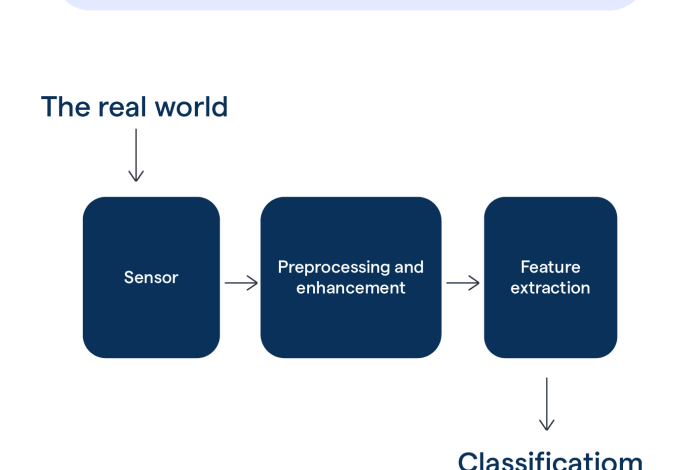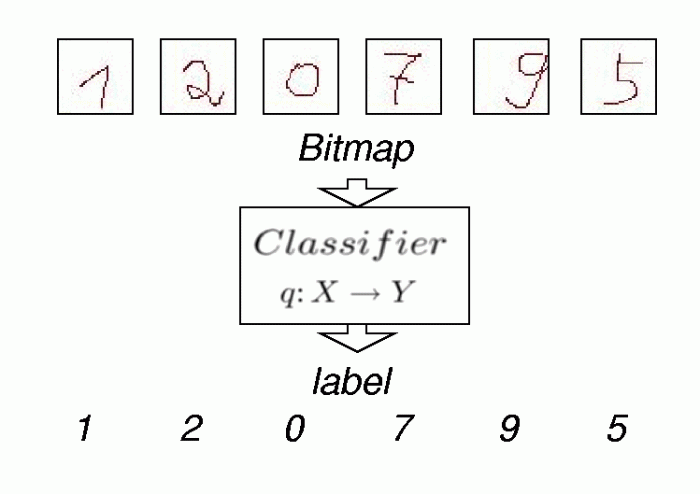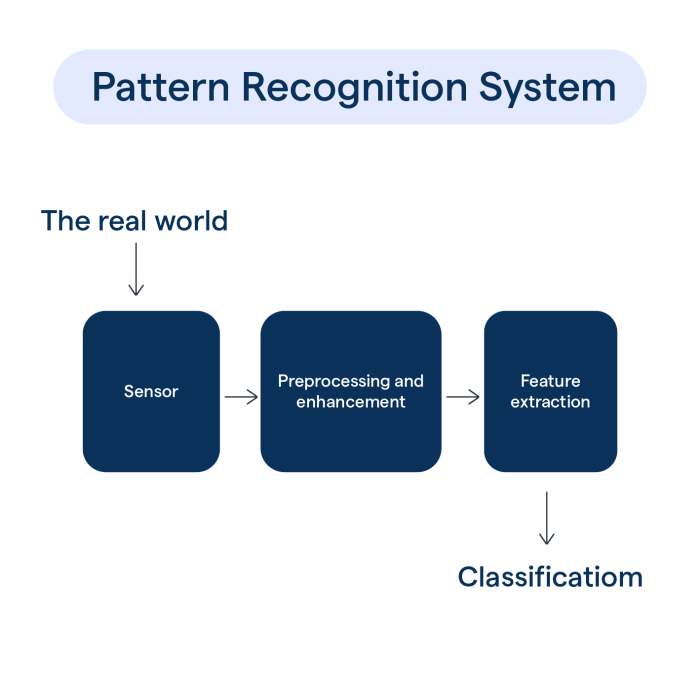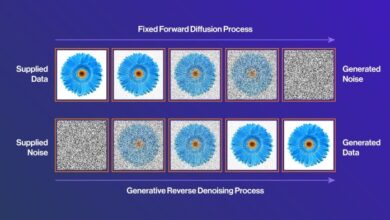
Definition of pattern recognition explores how we identify recurring structures in data, from visual images to complex numerical patterns. This insightful exploration delves into the core concepts, highlighting various types of patterns and distinguishing pattern recognition from related fields like classification and clustering. We’ll examine different approaches, like statistical methods, machine learning algorithms, and deep learning, comparing their strengths and weaknesses in recognizing patterns.
The journey continues as we analyze real-world applications in healthcare, finance, and security, demonstrating how these methods solve practical problems.
The process itself is broken down into manageable steps, from data acquisition to feature extraction, pattern recognition, and evaluation. We’ll examine a specific machine learning algorithm, like Support Vector Machines (SVMs), and see how these methods are applied in diverse domains like image processing and speech recognition. Understanding the crucial steps involved in a typical pattern recognition process is fundamental to grasping the intricacies of this field.
Furthermore, the evaluation of pattern recognition systems is critical, emphasizing key metrics like accuracy, precision, and recall.
Defining Pattern Recognition
Pattern recognition is a fundamental concept in various fields, from computer science to biology. It’s the ability to identify recurring structures or regularities in data, be it visual, auditory, or numerical. This process is crucial for automating tasks, extracting meaningful insights, and ultimately understanding the world around us. It forms the basis for many sophisticated technologies, like image analysis, speech recognition, and medical diagnosis.The core idea is to find and interpret patterns in information to make predictions, classify data points, or discover underlying structures.
This often involves using algorithms and statistical models to analyze data and identify recurring patterns, which are then used to understand the data’s meaning.
Types of Patterns
Pattern recognition can analyze various types of data. Visual patterns involve identifying shapes, objects, or textures in images. Auditory patterns encompass identifying sounds, melodies, or speech patterns in audio data. Numerical patterns, as the name suggests, deal with identifying recurring sequences or relationships in numerical data. Biological systems, too, exhibit intricate patterns, which are often studied using pattern recognition techniques to understand their behavior and function.
Pattern recognition, simply put, is spotting recurring themes or trends. Think of it like identifying a familiar face in a crowd. This concept extends far beyond everyday observations; analyzing President Donald Trump’s health physical results medical records president donald trump health physical results medical records could potentially involve identifying patterns in his medical history. Ultimately, recognizing these patterns can help us understand and predict future outcomes, whether in medical diagnoses or any other field.
Pattern Recognition vs. Related Fields
Pattern recognition is closely related to, but distinct from, other fields like classification and clustering. Classification focuses on assigning data points to predefined categories based on their characteristics. Clustering, on the other hand, groups similar data points together without pre-defined categories. Pattern recognition often underpins both classification and clustering by identifying the patterns that distinguish or group data points.
Pattern recognition, essentially, is about identifying recurring characteristics or sequences in data. It’s a fundamental concept in various fields, and a fascinating example of this in action is the interview with Dina Powell McCormick and David McCormick. Their insights into political strategy and policy decisions provide a compelling real-world application of identifying patterns in complex situations. Ultimately, understanding how to recognize patterns is crucial for effective decision-making across many disciplines.
Dina Powell McCormick and David McCormick interview offers a good case study of applying pattern recognition in a dynamic environment.
It provides the groundwork for determining how to classify or cluster effectively.
Comparison of Approaches
| Approach | Description | Strengths | Weaknesses |
|---|---|---|---|
| Statistical | Relies on statistical methods to identify patterns in data. It often involves calculating probabilities and distributions to determine the likelihood of patterns. | Generally robust, well-understood, and mathematically sound. Often computationally less demanding than other approaches. | Can be less effective with complex or high-dimensional data. May struggle with non-linear patterns. |
| Machine Learning | Employs algorithms that learn from data to identify patterns. This approach allows the model to adapt and improve its performance as more data becomes available. | Highly adaptable and can handle complex patterns. Can perform well with high-dimensional data. | Requires substantial amounts of training data. Interpretation of the model’s learned patterns can be challenging. Susceptible to overfitting. |
| Deep Learning | A subset of machine learning that uses artificial neural networks with multiple layers to extract complex patterns from data. These networks learn hierarchical representations of the data. | Exceptional performance on complex tasks like image and speech recognition. Can automatically learn complex features from data. | Computationally intensive, requiring significant resources. Often opaque, making it difficult to understand the learned patterns. Highly susceptible to biases in training data. |
Methods and Techniques
Pattern recognition relies heavily on various methods and techniques to extract meaningful information from data. These methods range from simple statistical analysis to complex machine learning algorithms, each playing a crucial role in identifying patterns and making predictions. Choosing the appropriate method depends on the nature of the data and the specific problem being addressed. This section delves into these methods, highlighting their applications in diverse real-world scenarios.
Pattern recognition, simply put, is spotting recurring elements in data. Think about how we process information all the time, and this relates directly to the global outpouring of grief surrounding Pope Francis’s death, and the political reactions, like those from Joe Biden and Donald Trump, at his funeral. This event highlights how we quickly identify patterns in behaviour, political stances, and even expressions of grief.
Ultimately, pattern recognition helps us understand the world around us, whether it’s complex political situations or everyday observations.
Common Methods in Pattern Recognition
Different methods contribute to the overall pattern recognition process. Statistical analysis provides a foundation by enabling us to quantify the data and identify distributions, correlations, and trends. Machine learning algorithms, especially supervised learning approaches, build models that learn from labeled data, enabling them to predict patterns in new, unseen data. This combination of statistical analysis and machine learning often yields powerful and accurate results.
Machine Learning Algorithms
Machine learning algorithms are at the forefront of many pattern recognition tasks. Among these, Support Vector Machines (SVMs) stand out for their ability to classify data into distinct categories.
Support Vector Machines (SVM)
Support Vector Machines (SVMs) are a powerful supervised learning algorithm used for classification and regression tasks. They work by finding an optimal hyperplane that maximally separates data points of different classes. The core concept involves finding the hyperplane that maximizes the margin between the closest data points of different classes. These closest points are known as support vectors, hence the name.
The algorithm aims to find the hyperplane that best generalizes to unseen data, minimizing the risk of overfitting.
The optimal hyperplane is determined by solving a constrained optimization problem.
This optimization process aims to maximize the margin between the support vectors.
Real-World Applications
SVMs are applied in a wide range of real-world scenarios, including:
- Image Classification: SVMs can be used to classify images into different categories, such as identifying different types of objects in a photograph. For example, an SVM model could be trained to distinguish between different types of flowers, categorizing them accurately.
- Medical Diagnosis: SVMs can assist in medical diagnoses by analyzing patient data to identify patterns indicative of specific diseases. For instance, an SVM model trained on medical images and patient records could help detect cancerous tissues more accurately.
- Spam Detection: In email systems, SVMs can be employed to classify emails as spam or not spam, filtering out unwanted messages.
Pattern Recognition in Different Domains
Pattern recognition plays a significant role across various domains.
- Image Processing: In image processing, pattern recognition techniques are used for tasks such as object detection, image segmentation, and image retrieval. For example, identifying faces in a crowd or recognizing objects in satellite imagery are common applications.
- Speech Recognition: Speech recognition systems utilize pattern recognition to convert spoken words into text. This is crucial for voice assistants and dictation software. A key aspect is identifying the distinct acoustic patterns corresponding to different phonemes or syllables.
Typical Pattern Recognition Process
The pattern recognition process typically involves several steps.
| Step | Description |
|---|---|
| Data Acquisition | Collecting the data relevant to the problem. This may involve gathering data from various sources, such as sensors, databases, or user inputs. |
| Feature Extraction | Selecting and extracting the most relevant features from the data. This step aims to represent the data in a way that effectively captures the patterns. For example, in image recognition, features like edges, corners, or textures might be extracted. |
| Pattern Recognition | Applying a suitable algorithm to identify patterns within the extracted features. This could involve using statistical analysis, machine learning, or other techniques. |
| Evaluation | Assessing the accuracy and performance of the identified patterns. This often involves evaluating the model’s performance on a test dataset that was not used during training. Metrics like precision, recall, and F1-score are often used. |
Applications of Pattern Recognition

Pattern recognition, a powerful branch of artificial intelligence, has found diverse applications across various fields, transforming how we approach problem-solving and decision-making. Its ability to identify intricate patterns in data enables systems to learn from past experiences and predict future outcomes with increasing accuracy. This capability is crucial for handling the massive amounts of data generated daily in domains like healthcare, finance, and security.The core principle behind pattern recognition applications is the extraction of meaningful information from complex datasets.
By analyzing these datasets, systems can identify subtle trends, anomalies, and correlations that would be impossible for humans to discern. This automated analysis empowers professionals in various sectors to make more informed decisions, leading to significant improvements in efficiency and effectiveness.
Applications in Healthcare
Pattern recognition is revolutionizing healthcare, enabling advancements in diagnosis, treatment, and patient care. By analyzing patient data, including medical history, symptoms, and test results, systems can identify patterns indicative of specific diseases. This capability streamlines the diagnostic process, potentially leading to faster and more accurate diagnoses.
- Diagnosis of Diseases: Machine learning algorithms can analyze medical images (X-rays, CT scans, MRIs) to identify patterns indicative of diseases like cancer or other pathologies. For instance, deep learning models trained on thousands of mammograms can detect subtle anomalies in breast tissue, potentially aiding in early cancer detection. This automation reduces the time and effort required for diagnosis and improves the accuracy of results compared to human analysis alone.
- Prediction of Patient Outcomes: Pattern recognition systems can analyze patient data to predict future health risks and outcomes. By identifying patterns associated with high-risk factors, such as age, lifestyle, and genetic predispositions, systems can alert medical professionals to potential complications and allow for proactive interventions. This approach is vital in preventive healthcare, empowering individuals and healthcare providers to take preventative measures.
- Drug Discovery: Pattern recognition plays a critical role in drug discovery. By analyzing vast datasets of molecular structures and biological processes, systems can identify potential drug candidates with desirable properties. For example, analyzing patterns in the interactions of molecules with specific targets can lead to the development of novel drugs for various diseases.
- Personalized Medicine: Pattern recognition facilitates the development of personalized medicine approaches. By analyzing an individual’s unique genetic makeup, lifestyle, and medical history, systems can tailor treatment plans to optimize outcomes. This approach ensures that treatments are tailored to the specific needs of each patient, maximizing effectiveness and minimizing side effects.
Applications in Finance
In the financial sector, pattern recognition is instrumental in fraud detection, risk assessment, and algorithmic trading. By analyzing vast amounts of financial data, systems can identify suspicious transactions and predict market trends. This capability helps in safeguarding financial institutions from fraud and in making more informed investment decisions.
Applications in Security
Pattern recognition systems are employed in various security applications, from surveillance to threat detection. These systems can analyze large volumes of data, including video footage, sensor readings, and network traffic, to identify anomalies and potential threats. This ability to detect deviations from expected patterns is critical in preventing cyberattacks and protecting sensitive information. An example would be detecting unusual login patterns in a system to identify potential unauthorized access.
Evaluation and Measurement

Evaluating the performance of pattern recognition systems is crucial for understanding their strengths and weaknesses, optimizing their design, and ultimately ensuring their effectiveness in real-world applications. Accurate assessment involves meticulous analysis of various metrics, enabling informed decisions regarding system selection and improvement. A robust evaluation framework provides a structured approach to assessing the reliability and accuracy of pattern recognition systems.The evaluation process transcends simple correctness; it delves into the nuances of performance, considering factors like the system’s ability to handle diverse data types, its responsiveness to changing conditions, and its generalizability across different datasets.
This nuanced approach ensures that the chosen system not only accurately identifies patterns but also performs reliably and efficiently in a wide range of practical scenarios.
Key Performance Metrics
Understanding the performance of a pattern recognition system necessitates the use of well-defined metrics. These metrics quantify different aspects of the system’s behavior, providing a comprehensive evaluation.
- Accuracy: This metric represents the proportion of correctly classified instances out of the total instances. A higher accuracy indicates a more reliable system.
- Precision: Precision measures the proportion of correctly predicted positive instances among all predicted positive instances. A high precision suggests that the system is minimizing false positives.
- Recall: Recall, also known as sensitivity, measures the proportion of correctly predicted positive instances among all actual positive instances. A high recall indicates that the system is minimizing false negatives.
- F1-score: This metric balances precision and recall, providing a single value that represents the overall performance of the system. A higher F1-score signifies a better trade-off between precision and recall.
Calculating and Interpreting Metrics
Calculating these metrics involves specific formulas and interpretations.
- Accuracy is calculated by dividing the number of correctly classified instances by the total number of instances. For example, if a system correctly classifies 90 out of 100 instances, its accuracy is 90%. Interpretation: High accuracy suggests the system is generally reliable in its classifications.
- Precision is calculated by dividing the number of correctly predicted positive instances by the total number of predicted positive instances. If a system predicts 80 instances as positive, and 70 of them are actually positive, the precision is 70/80 = 87.5%. Interpretation: High precision implies that when the system predicts a positive instance, it is mostly correct.
- Recall is calculated by dividing the number of correctly predicted positive instances by the total number of actual positive instances. If 90 instances are actually positive, and the system correctly identifies 80, the recall is 80/90 = 88.9%. Interpretation: High recall indicates that the system captures a significant portion of the actual positive instances.
- F1-score is calculated as 2
– [(Precision
– Recall) / (Precision + Recall)]. This harmonic mean balances precision and recall. For example, if precision is 80% and recall is 90%, the F1-score is 87.09%. Interpretation: A high F1-score signifies a good overall performance balance between identifying true positives and avoiding false positives/negatives.
Evaluation Framework
A robust framework for assessing pattern recognition systems involves a structured approach. The framework should include multiple steps.
- Dataset Splitting: Divide the data into training, validation, and testing sets to evaluate the system’s performance on unseen data.
- Metric Selection: Choose appropriate metrics based on the specific application to assess the system’s strengths and weaknesses.
- Comparative Analysis: Evaluate different algorithms or approaches to determine the optimal system for the given task.
- Cross-Validation: Employ cross-validation techniques to assess the generalizability of the system’s performance across different data subsets.
Performance Metrics Summary
| Metric | Description | Formula (if applicable) |
|---|---|---|
| Accuracy | Proportion of correctly classified instances | Correctly Classified Instances / Total Instances |
| Precision | Proportion of correctly predicted positive instances among all predicted positive instances | True Positives / (True Positives + False Positives) |
| Recall | Proportion of correctly predicted positive instances among all actual positive instances | True Positives / (True Positives + False Negatives) |
| F1-score | Harmonic mean of precision and recall | 2
|
Challenges and Limitations: Definition Of Pattern Recognition
Pattern recognition, while powerful, faces inherent limitations. These limitations stem from the complexities of real-world data, the inherent biases in training data, and the difficulty in evaluating the robustness and generalizability of learned models. Addressing these challenges is crucial for building reliable and trustworthy pattern recognition systems.Understanding the challenges and limitations in pattern recognition is paramount for developing effective and responsible applications.
This includes recognizing potential biases, evaluating the impact of data quality, and exploring methods to mitigate these issues. The quality and quantity of data play a significant role in the accuracy and reliability of pattern recognition systems.
Common Challenges and Limitations
Pattern recognition systems are susceptible to various challenges. These include the presence of noisy data, the need for large and representative datasets, and the potential for overfitting or underfitting models. The choice of algorithm and its parameters also influences the system’s performance and can introduce biases. Furthermore, interpreting the results of pattern recognition models can be complex and require careful consideration of the context.
Potential Biases and Errors
Biases in training data can lead to discriminatory or unfair outcomes in pattern recognition systems. For example, if a facial recognition system is trained primarily on images of one demographic, it may perform poorly on images of other demographics. Similarly, data sets that are imbalanced (e.g., more instances of one class than others) can lead to models that favor the majority class.
In such cases, the system may exhibit a bias towards recognizing certain patterns more readily than others, potentially perpetuating societal prejudices. Therefore, careful consideration of data diversity and the potential for bias is crucial in developing responsible pattern recognition systems.
Importance of Addressing Challenges, Definition of pattern recognition
Addressing the challenges and limitations of pattern recognition is vital for ensuring the reliability and ethical use of these systems. Inaccurate or biased predictions can have significant real-world consequences, from misdiagnosing diseases to unfairly denying loans. Careful consideration of data quality, potential biases, and appropriate evaluation metrics are crucial for responsible deployment. By mitigating these issues, we can foster trust in the results and prevent unfair or harmful outcomes.
Role of Data Quality and Quantity
Data quality significantly impacts the performance of pattern recognition systems. Inaccurate, incomplete, or inconsistent data can lead to erroneous patterns and unreliable predictions. Furthermore, the quantity of data influences the model’s ability to generalize and make accurate predictions on unseen data. Sufficient data samples are essential to capture the variability and nuances within the patterns being recognized.
Limited or insufficient data can lead to poor performance, potentially affecting the accuracy and reliability of the system. A balance between the quality and quantity of data is required to achieve optimal performance.
Methods for Handling Noisy Data
Noisy data, characterized by errors or outliers, is a common challenge in pattern recognition. Several techniques can help mitigate the impact of noise. One approach involves data preprocessing steps like smoothing, filtering, or outlier removal. These methods can reduce the influence of noise and improve the accuracy of the learned patterns. Another strategy involves using robust algorithms that are less sensitive to noise.
These algorithms can learn from the data even in the presence of noise, thereby improving the accuracy of the results.
Conclusive Thoughts
In conclusion, pattern recognition is a powerful tool with wide-ranging applications across various fields. We’ve explored the fundamental concepts, methods, and real-world applications of this field. However, we also acknowledge the challenges and limitations of pattern recognition systems, including potential biases and errors. Understanding these limitations is crucial for developing reliable and effective pattern recognition systems, emphasizing the importance of data quality and quantity.
Future advancements in this field hold exciting prospects, and addressing the challenges will be critical for continued progress.




